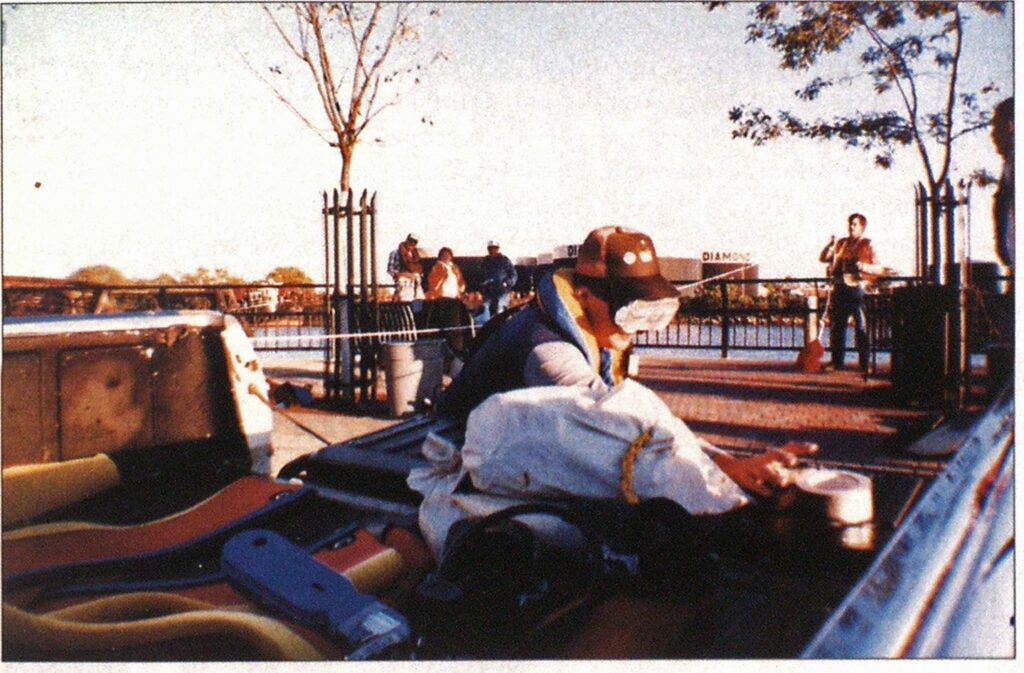
TRAINING DIVERS FOR MINIMAL OR ZERO VISIBILITY
DIVE RESCUE

Rescue divers often operate in minimal visibility—one to two feet at best—or in zero visibility. Operating in zero visibility is similar to searching a smoke-filled room for a small child in a fully involved situation. The main difference is that the bottom of a lake, river, or pond is not quite as familiar to the diver as the walls, doors, and furniture are to the firefighter. In a smoke-filled room there are basic rules that you can follow to determine where the child might be hiding, but underwater the child could be anywhere —even if he is six inches away you might miss him.
In minimal visibility you can’t see your hand stretched out in front of you. Although this sounds slightly better than no visibility at all, everything within sight becomes the center of attention, which can startle the diver and throw him off the track. The truth is, both limitedand zero-visibility waters are very difficult to work in, but with the proper training you can increase your chances of a successful search.
TETHERED DIVER LAND PRACTICE
Your first goal is to train your divers to perform the steps of gearing up as routine. First have them don the harness and buoyancy compensator device. Next, let them put black or brown material inside their masks to simulate zero visibility. (When it comes to a real dive, I often wish I could deploy divers wearing blackedout masks to eliminate the tendency to become distracted by insignificant objects in limited-visibility water.)
While the diver is standing next to die tender, attach the safety line. It is a good idea to work with at least three diver/tender teams to add an element of chaos and confusion.
Once the diver is standing next to the tender, the tender can no longer move from his spot or speak to the diver. The tender has to do all of his directing from that one spot. He must communicate either with gentle, directional tugs on the tether line or with wire or wireless communication devices if available.
Once the diver’s eyes are covered, hide objects within 60 to HO feet of him. Try not to make the objects easy to find. You can hide keys, a closed pocket knife, or anything you choose. Try placing the tender/diver teams so that their safety lines must cross on their way to the search area. This teaches the tenders to communicate with each other and be more aware of other divers. Also, make the divers crawl over and under objects when heading for the search area to make the drill as real as possible.
After the divers are deployed, mark time tor the operation is 10 to 15 minutes. Note the following:
- Can the tender direct the diver with proficiency?
- What areas did the diver miss in his immediate search zone?
- Is the diver moving too quickly?
- Can the diver and tender in each team work together?
- Does the diver understand what a search area is and how to be sure that the search is over and that the object wasn’t missed? (See “Locating Your Objective,” Fire Engineering, July 1989, page 49.)
- Are you taking advantage of obstacles so that the tender will realize how difficult it is to guide the diver, even when he can see what they’re searching for?
After several successful drills of this type, try taking your blindfolded divers to a new area. Again, hide the objects and then deploy your teams. This time, do not tell the tenders where the object is, just approximately where and what it is they are searching for. It doesn’t matter how much area they search as long as they are sure that they haven’t unknowingly missed a part of the search area or missed the object. Allow 15 to 18 minutes for this exercise. Again, if you have underwater communication available, use it: It will make the search easier.
UNTETHERED DIVER LAND PRACTICE
I do not recommend using untethered divers very often. There are certainly situations in which the untethered diver has advantages, but lines guarantee the best safety and control of your team members.
Untethered divers tend to be very inefficient in limited visibility, since they cannot be sure where they have been and where they are going unless premeasured, preset lines have been set up underwater.
Training untethered divers is similar to training tethered divers. Have the divers put on their buoyancy compensator devices and blackout masks and then let them begin the search. Remember, you cannot speak to the divers once they have started the search unless you have wireless communication. Before the search has begun, simply tell them what the search object is and how far away it is. If they can’t find their way in the drill, just think of what would happen in the bottom of a lake or river! This exercise should last 10 to 12 minutes.
Videotape the drills to examine the positive and negative aspects of your tethered and untethered training programs. Use the tapes in the debriefing to continue the lesson.
It is important for you to keep in mind as your divers get better at such exercises that one or two successes does not mean they know all there is to know about dive rescue. Make the exercises more and more difficult and then eventually move them into the water.


